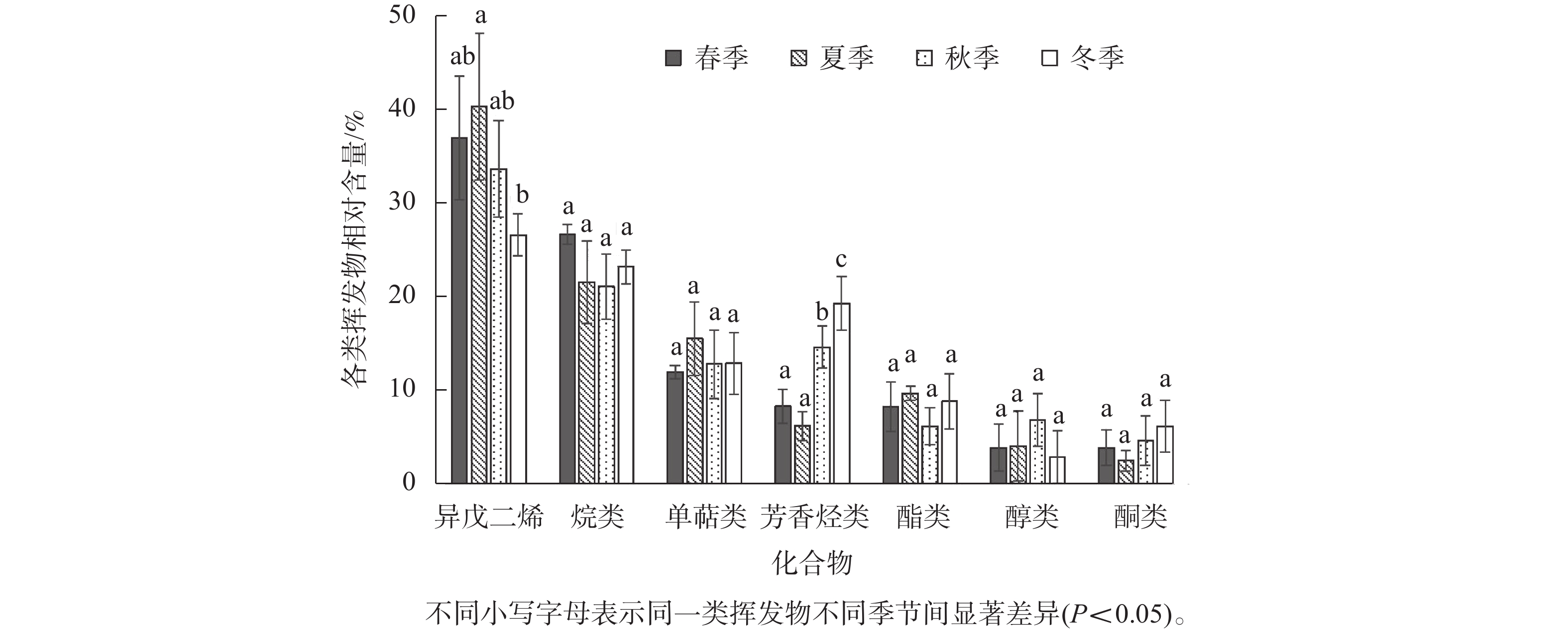-
植物挥发性有机化合物(volatile organic compounds, VOCs)是一类经植物次生代谢合成并排放到空气中的小分子化合物,其年排放量占全球挥发性有机化合物年排放总量的90%以上[1]。VOCs的成分有3万多种[2],全球的VOCs释放以异戊二烯为主,约占总释放量的50%[3]。一定浓度的VOCs对促进植物生长与繁殖[4],调节气候变化[5],改善人体健康并且预防一些慢性疾病[6]等发挥着重要作用。竹子是一种重要的森林资源,中国第9次森林资源清查结果显示:中国竹资源丰富,竹林面积为641.16万hm2,其中毛竹Phyllostachys edulis林为467.78万hm2,占72.96%[7]。作为异戊二烯释放量较大的笋材两用竹种[8−9],毛竹具有再生能力强、生长期快、造林周期短、产量高等特点,具有较高的生态经济价值[10]。目前,对毛竹VOCs的研究大多集中在叶片或单株尺度[11−13]。张莉等[11]研究指出:毛竹是异戊二烯释放量较大的一种植物,其释放与气温和光照度的变化有着密切的关系;SONG等[12]量化了茎龄对毛竹叶片异戊二烯释放量的影响;CHANG等[13]也证实了除了光照度和气温等外界环境,毛竹的异戊二烯释放量还受到毛竹单位面积叶质量的影响。而基于毛竹林分尺度的VOCs释放特点及其与环境因子的关系研究较少[14],需要进一步研究探索。浙江省绍兴市诸暨五泄景区森林覆盖率达90%以上,天然植被茂密,种类繁多,其中毛竹林面积大,树种均匀度和自然度高,人为干扰小,可作为野外实验的重要场所[15]。本研究选取景区内代表性毛竹林分为研究对象,采集了4个不同季节以及同一季节同一天上午、中午和下午3个时间段的毛竹林内VOCs,分析鉴定其日变化和季节变化规律及其与环境因子的关系,以期为毛竹的进一步开发利用提供理论依据,同时为进一步构建森林VOCs释放特征模型提供数据支持。
-
样地设置在浙江省绍兴市诸暨五泄景区(27°03′~31°11′N, 118°02′~123°08′E)。该地地处浙东低山丘陵地带,属亚热带季风气候区,气候温和,四季分明,雨量较多,光照充足。年平均气温为16.2 ℃,年平均降水量为1 346.7 mm,年平均降雨日为158.7 d。选取景区内代表性毛竹林分为研究对象:海拔为223.9 m,中坡为140°,平均胸径为11.54 cm,林分密度为3 500株·hm−2,林分面积约为0.87 hm2。该毛竹林2021年为小年,2022年为大年。在林分中心根据5点采样法[16]随机设置5个VOCs采样点(离地面高度1.5 m),每个采样点之间相隔约20 m。
-
选择晴朗天气,于2021年10月28—30日(秋季),2022年1月11—13日(冬季),2022年5月3—5日(春季),2022年7月20—22日(夏季)的9:00—11:00(上午), 11:30—13:30(中午), 14:00—16:00(下午)3个时段,在5个采样点用不锈钢吸附管(通用型5266,MARKES)对VOCs进行连续采样;便捷式采样仪(北京市劳动保护科学研究所)设置采样流速为150 mL·min−1,每个样品富集18 L空气,每个季度45根样品,共获得180根样品。采样后使用便携式气相色谱-质谱联用仪(GC-MS,EXPEC 3500,杭州谱育科技发展有限公司)吸附管模块对样品进行分析,以获得各季节毛竹林VOCs在3 d内上午、中午和下午3个时段的成分和摩尔分数,计算各季节3 d中各时段的平均值,得出各季节VOCs日变化规律;计算各季节林分VOCs日均摩尔分数,取3 d的平均值,作为各季节VOCs的释放水平,得出VOCs季节摩尔分数变化规律;统计各季节3 d中出现过的所有VOCs种类数量,作为各季节VOCs的释放水平。使用浙江农林大学自主研发的环境气象监测站测定林分内环境因子,气象监测站距离地面高度为2 m,布设于样地中心。测量指标包括气温、相对湿度、光照度、细颗粒物(PM2.5)、可吸入颗粒物(PM10)、风速、二氧化碳(CO2)。测量时间间隔为1 min,测量数据实时上传到网络平台。
-
使用质谱仪数据分析软件结合保留时间、峰面积、标准质谱图和美国国家标准与技术研究所(NIST)的标准参考数据库判断组分种类,使用面积归一化外标法计算摩尔分数。外部标准曲线使用物质标准品和色谱级甲醇溶液配置各摩尔分数梯度标准溶液(5、10、20、50 nmol·mol−1)后以便携式气相色谱-质谱联用仪进行定量。根据实测结果和文献研究[17−18],确定目标物质并分析其摩尔分数变化,萜烯类物质标样有:叶醇、萜烯醇、3-蒈烯、2-蒎烯、崁烯,其他物质使用臭氧前体混合物(PAMS)气体标样定量。标样之外的单萜摩尔分数使用2-蒎烯的标准曲线公式计算,烷摩尔分数使用3-甲基庚烷标准曲线公式计算,芳香烃摩尔分数使用甲苯的标准曲线公式计算,醇类和其他物质摩尔分数使用叶醇的标准曲线公式计算。每个目标化合物的绝对摩尔分数根据标准曲线计算,目标化合物的峰面积和已知标准摩尔分数间的拟合函数拟合优度均高于0.99。
-
采用Excel 2016和Origin 2022对数据进行统计并作图,用SPSS 22 统计分析软件对所有试验数据进行单因素方差分析(ANOVA)。
-
通过吸附管采集的毛竹林内VOCs经GC-MS分析测定,共鉴定出51种化合物(表1),包含烷类18种、萜烯类11种(包括单萜类10种和异戊二烯1种。因毛竹林内异戊二烯摩尔分数较大,本研究将萜烯类分为异戊二烯和单萜类分别进行分析)、芳香烃类7种、酯类5种、醇类5种以及酮类5种,共6类化合物。其中春季化合物数量最多,共鉴定出44种;夏季、秋季次之,均为40种;冬季最少,仅检测到27种化合物。
化合物种类 化合物 分子式 摩尔分数/(nmol·mol−1) 春季 夏季 秋季 冬季 烷类 2-甲基戊烷 C6H14 0.086±0.023 0.124±0.051 0.094±0.049 0.081±0.071 1,2-二氯乙烷 C2H4Cl2 0.059±0.025 0.113±0.153 0.134±0.063 0.250±0.084 2-甲基己烷 C7H16 0.040±0.010 0.110±0.048 0.083±0.027 − 3-甲基己烷 C7H16 0.050±0.015 0.137±0.121 0.090±0.036 0.117±0.036 1,2-二氯丙烷 C3H6Cl2 0.070±0.066 0.230±0.049 0.236±0.106 0.238±0.082 正戊烷 C5H12 0.078±0.041 0.331±0.070 0.120±0.058 0.187±0.060 甲基环己烷 C7H14 0.045±0.012 0.162±0.043 0.061±0.016 0.094±0.022 2-甲基庚烷 C8H18 0.033±0.009 − 0.025±0.000 − 3-甲基庚烷 C8H18 0.278±0.151 0.183±0.064 0.351±0.219 − 正辛烷 C8H18 0.073±0.029 0.313±0.074 0.212±0.094 0.196±0.124 正壬烷 C9H20 0.036±0.016 − 0.062±0.021 0.050±0.009 正癸烷 C10H22 0.178±0.077 0.256±0.142 0.213±0.071 − 十一烷 C11H24 0.197±0.073 − − − 2-甲基癸烷 C11H24 0.204±0.109 0.152±0.080 − − 十二烷 C12H26 0.264±0.091 0.198±0.070 − − 4-甲基癸烷 C11H24 0.128±0.046 − − − 十三烷 C13H28 0.192±0.019 0.162±0.091 − − 十四烷 C14H30 0.149±0.035 − − − 萜烯类 异戊二烯 C5H8 2.952±0.709 4.370±1.173 2.399±0.611 1.242±0.336 α-蒎烯 C10H16 0.173±0.046 0.325±0.086 0.288±0.124 0.238±0.079 柠檬烯 C10H16 − 0.070±0.012 0.116±0.083 0.109±0.069 桉叶油醇 C10H18O 0.049±0.017 0.204±0.114 − − 3-蒈烯 C10H16 0.046±0.018 0.231±0.116 0.262±0.238 − 月桂烯 C10H16 − − 0.013±0.000 − 左旋-beta-蒎烯 C10H16 0.159±0.075 0.171±0.103 − 0.081±0.028 萜品油烯 C10H16 − 0.156±0.092 0.097±0.032 − β-pinene C10H16 0.119±0.041 0.197±0.095 0.250±0.169 0.184±0.078 莰烯 C10H16 0.174±0.098 0.153±0.071 0.194±0.107 0.092±0.050 薄荷脑 C10H20O 0.323±0.128 0.113±0.052 − − 芳香烃类 苯 C6H6 0.180±0.042 0.144±0.079 0.302±0.092 0.136±0.045 甲苯 C7H8 0.250±0.093 0.169±0.030 0.194±0.067 0.190±0.051 乙苯 C8H10 0.075±0.031 0.121±0.059 0.233±0.055 0.209±0.046 1, 2-二甲苯 C8H10 0.067±0.038 0.114±0.073 0.140±0.057 0.178±0.050 苯乙烯 C8H8 0.109±0.059 − 0.062±0.033 − 1, 3-二甲苯 C8H10 0.110±0.072 0.104±0.039 0.174±0.071 0.236±0.065 叔丁基苯 C10H14 − − 0.064±0.000 − 酯类 乙酸乙酯 C4H8O2 0.362±0.138 0.147±0.084 − − 乙酸丙酯 C5H10O2 0.155±0.025 0.213±0.082 0.262±0.098 − 乙酸正丁酯 C6H12O2 0.046±0.006 0.184±0.032 0.128±0.039 0.154±0.041 乙酸异丁酯 C6H12O2 0.053±0.003 0.284±0.076 0.235±0.068 0.224±0.088 乙酸戊酯 C7H14O2 0.195±0.107 0.169±0.060 − − 醇类 1-庚醇 C7H16O − 0.107±0.034 0.072±0.031 0.132±0.037 异丙醇 C3H8O 0.182±0.146 − 0.140±0.073 − 2-乙基己醇 C8H18O 0.109±0.043 0.077±0.023 0.127±0.138 0.070±0.027 1-十一醇 C11H24O 0.144±0.057 0.414±0.086 0.182±0.076 − 1-癸醇 C10H22O 0.102±0.028 0.376±0.349 0.192±0.111 − 酮类 2-丁酮 C4H8O 0.180±0.059 0.188±0.053 0.155±0.071 0.132±0.097 2-甲基环己酮 C7H12O 0.073±0.036 0.097±0.033 0.093±0.093 0.067±0.014 环己酮 C6H10O − − 0.060±0.021 0.068±0.000 二异丁基酮 C9H18O − − 0.193±0.094 0.109±0.069 2-十一酮 C11H22O 0.128±0.000 0.181±0.000 0.132±0.141 − 说明:-表示未检出该物质。 Table 1. VOCs fraction and concentration in a Ph. edulis forest
受植物自身生理情况及外界环境因素的影响,毛竹林不同季节各类VOCs成分有所差别,主要成分也不相同。烷类化合物春季主要成分为3-甲基庚烷(0.278 nmol·mol−1)和十二烷(0.264 nmol·mol−1),夏季主要成分为正戊烷(0.331 nmol·mol−1)和正辛烷(0.313 nmol·mol−1),秋季主要成分为三甲基庚烷(0.351 nmol·mol−1),冬季主要成分为1, 2-二氯乙烷(0.250 nmol·mol−1)和1, 2-二氯丙烷(0.238 nmol·mol−1);萜烯类化合物在春、夏、秋、冬四季主要成分均为异戊二烯,分别为2.952、4.370、2.399、1.242 nmol·mol−1;芳香烃类化合物在春、夏两季主要成分均为甲苯,分别为0.250和0.169 nmol·mol−1,秋季主要成分为苯(0.302 nmol·mol−1),冬季主要成分为1,3-二甲苯(0.236 nmol·mol−1);酯类化合物春季主要成分为乙酸乙酯(0.362 nmol·mol−1),秋季主要成分为乙酸丙酯(0.262 nmol·mol−1),夏季和冬季主要成分均为乙酸异丁酯,分别为0.284和0.224 nmol·mol−1;醇类化合物春季主要成分为异丙醇(0.182 nmol·mol−1),夏季主要成分为1-十一醇(0.414 nmol·mol−1)和1-癸醇(0.376 nmol·mol−1),秋季主要成分为1-癸醇(0.192 nmol·mol−1)和1-十一醇(0.182 nmol·mol−1),冬季主要成分为1-庚醇(0.132 nmol·mol−1);酮类化合物春、夏、冬三季主要成分均为2-丁酮,分别为0.180、0.188、0.132 nmol·mol−1,秋季主要成分为二异丁基酮(0.193 nmol·mol−1)。
-
如图1所示:从季节来看,毛竹林总VOCs摩尔分数从高到低依次为夏季、春季、秋季、冬季。夏季检测到的总VOCs摩尔分数最高,为10.600 nmol·mol−1,春季、秋季、冬季分别为8.068、7.254、4.432 nmol·mol−1。夏季总VOCs摩尔分数显著(P<0.05)高于秋季,秋季显著(P<0.05)高于冬季,春季显著高(P<0.05)于冬季;春季与夏季、春季与秋季之间差异不显著。由此可见,不同季节的毛竹林内总VOCs摩尔分数差别较大。
-
如图2所示:毛竹林内各类VOCs中,萜烯类中的异戊二烯组分在4个季节的占比均最高,占总VOCs比例为26%~40%,其次为烷类,占比为21%~27%,醇类和酮类占比较低,仅为2%~7%。从各类VOCs在4个季节所占比例来看,异戊二烯在夏季所占比例最高,为40.28%,比在春季、秋季和冬季所占的36.93%、33.61%和26.60%分别高3.35%、6.67%和13.68%,夏季所占比例显著(P<0.05)高于冬季,其他季节之间差异不显著;烷类在春季所占比例最高,为26.66%,比冬季、夏季和春季所占的23.20%、21.57%和21.11%分别高3.46%、5.09%和5.55%,但四季间差异不显著;单萜类在夏季所占比例最高,为15.55%,比在冬季、秋季和春季所占的12.93%、12.84%和11.97%分别高2.62%、2.71%和3.58%,且四季之间差异也不显著;芳香烃类在冬季所占比例最高,为19.29%,比在秋季、春季和夏季所占的14.65%、8.33%和6.23%分别高4.64%、10.96%和13.06%,冬季占比显著(P<0.05)高于秋季,而秋季又显著(P<0.05)高于春季和夏季,春季和夏季之间差异不显著。酯类、醇类和酮类占比较低(低于10.00%),在4个季节相差不大,且差异均不显著。由此可见:各类VOCs占总VOCs比例均受季节变化影响,且异戊二烯和芳香烃2类物质受影响较大,不同季节间存在显著差异。毛竹是强异戊二烯释放树种,异戊二烯释放量高于其他各类物质。
-
如表2所示:春季, 总VOCs摩尔分数在上午达到最高,为9.074 nmol·mol−1,中午次之,为8.621 nmol·mol−1,下午最低,为6.509 nmol·mol−1。毛竹林内各类VOCs摩尔分数全天各时刻以异戊二烯最高,烷类、醇类和酮类较低。在中午,异戊二烯摩尔分数最高可达3.806 nmol·mol−1,占总VOCs的44.00%,上午次之,为2.838 nmol·mol−1,下午最低,为2.301 nmol·mol−1;烷类和单萜类摩尔分数日变化波动较小,且都为上午和中午时段较高,下午较低;芳香烃类摩尔分数日变化趋势与总VOCs日变化相近,从高到低依次为上午、中午、下午;酯类和醇类摩尔分数日变化波动较大,从高到低依次均为上午、下午、中午,且醇类摩尔分数上午约是中午的4倍;酮类摩尔分数从高到低依次表现为下午、中午、上午。
季节 时段 各VOCs组分及总VOCs摩尔分数/(nmol·mol-1) 异戊二烯 烷类 单萜类 芳香烃类 酯类 醇类 酮类 总VOCs 春季 上午 2.838±0.396 2.438±0.739 1.043±0.324 0.937±0.335 0.991±0.281 0.604±0.179 0.223±0.071 9.074±2.325 中午 3.806±0.351 2.198±0.444 1.102±0.385 0.600±0.134 0.483±0.156 0.156±0.057 0.276±0.107 8.621±1.633 下午 2.301±0.337 1.798±0.540 0.757±0.181 0.502±0.099 0.544±0.204 0.214±0.078 0.394±0.102 6.509±1.541 夏季 上午 3.841±0.670 3.084±0.658 1.546±0.374 0.592±0.188 1.158±0.212 0.972±0.471 0.441±0.091 11.634±2.663 中午 5.690±0.589 2.366±0.618 1.559±0.562 0.661±0.307 1.037±0.340 0.186±0.049 0.210±0.067 11.710±2.533 下午 3.316±0.303 1.521±0.492 1.696±0.803 0.674±0.138 0.876±0.256 0.199±0.059 0.174±0.027 8.455±2.077 秋季 上午 2.354±0.051 1.409±0.660 1.264±0.815 1.114±0.380 0.659±0.198 0.786±0.339 0.439±0.204 8.024±2.646 中午 3.161±0.103 1.709±0.857 0.702±0.385 1.036±0.222 0.341±0.112 0.541±0.384 0.549±0.345 8.038±2.410 下午 1.834±0.469 1.397±0.525 0.800±0.462 0.980±0.297 0.351±0.105 0.239±0.056 0.101±0.024 5.702±1.938 冬季 上午 1.194±0.130 1.118±0.441 0.651±0.251 1.032±0.169 0.331±0.182 0.054±0.014 0.201±0.057 4.580±1.243 中午 1.540±0.218 1.274±0.463 0.815±0.262 0.962±0.091 0.378±0.038 0.074±0.017 0.254±0.129 5.298±1.219 下午 0.843±0.268 0.723±0.209 0.314±0.057 0.587±0.056 0.418±0.115 0.211±0.075 0.322±0.174 3.418±0.955 Table 2. Concentration of VOCs in a Ph. edulis forest by season and time
夏季, 总VOCs摩尔分数在中午和上午较高,分别为11.710和11.634 nmol·mol−1,下午最低,为8.455 nmol·mol−1。毛竹林内各类VOCs摩尔分数全天各时刻以异戊二烯最高,其次为烷类,酮类较低。在中午,异戊二烯摩尔分数最高可达5.690 nmol·mol−1,约占总VOCs的50.00%,上午次之,为3.841 nmol·mol−1,下午最低,为3.316 nmol·mol−1;烷类、酯类和酮类摩尔分数日变化趋势相同,从高到低依次均为上午、中午、下午;单萜类和芳香烃类摩尔分数日变化波动较小,且均为下午和中午较高,上午较低;醇类摩尔分数日变化波动最大,从高到低依次为上午、下午、中午,且上午的摩尔分数是中午的5倍以上。
秋季, 总VOCs摩尔分数也体现为在中午和上午较高,分别为8.038和8.024 nmol·mol−1,下午最低,为5.702 nmol·mol−1。毛竹林内各类VOCs摩尔分数全天各时刻以异戊二烯最高,其次为烷类,酯类、醇类和酮类较低。中午时,异戊二烯摩尔分数最高可达3.161 nmol·mol−1,占总VOCs的40.00%,上午次之,为2.354 nmol·mol−1,下午最低,为1.834 nmol·mol−1;烷类和酮类摩尔分数日变化趋势与异戊二烯相同,从高到低依次均为中午、上午、下午;单萜类和酯类摩尔分数日变化趋势相同,从高到低依次均为上午、下午、中午;芳香烃类和醇类摩尔分数日变化趋势相同,从高到低依次为上午、中午、下午。从摩尔分数日变化波动来看,芳香烃类日变化波动最小,酮类最大。
冬季, 总VOCs摩尔分数在中午达到最高,为5.298 nmol·mol−1,上午次之,为4.580 nmol·mol−1,下午最低,为3.418 nmol·mol−1。毛竹林内各类VOCs摩尔分数全天各时刻以异戊二烯最高,其次为烷类,醇类最低。在中午,异戊二烯摩尔分数最高可达1.540 nmol·mol−1,占总VOCs的30.00%,上午次之,为1.194 nmol·mol−1,下午最低,为0.843 nmol·mol−1;烷类和单萜类摩尔分数日变化趋势与异戊二烯相同,从高到低依次均为中午、上午、下午;芳香烃类摩尔分数从高到低依次为上午、中午、下午;酯类、醇类和酮类摩尔分数日变化趋势相同,从高到低依次均为下午、中午、上午,且酯类日变化波动最小,醇类最大。
综合毛竹林内的VOCs摩尔分数在春季、夏季、秋季、冬季各时段的变化规律,可以发现:异戊二烯在4个季节的各时段均高于其他各类物质,且在4个季节均呈现出中午最高,上午次之,下午最低的规律。除春季外,其他各季节的总VOCs摩尔分数均呈现出中午最高,上午次之,下午最低的规律,其他各类物质摩尔分数所呈现的日变化规律在各季节有所不同,但总体趋势保持为上午和中午较高,下午较低。各类VOCs摩尔分数的日变化波动范围也较为不同,综合4个季节来看,醇类日变化波动最大,单萜烯和芳香烃日变化波动较小。
-
如图3所示:从四季整体来看,毛竹林内VOCs摩尔分数与各环境因子都有一定的相关性,其中,异戊二烯、总VOCs摩尔分数与环境因子的相关性表现出相似特征,均与气温存在极显著正相关(P<0.001),与PM2.5和PM10极显著负相关(P<0.01),与臭氧呈显著负相关(P<0.05),与其他环境因子相关不显著。烷类摩尔分数与气温存在极显著正相关(P<0.01),与PM2.5和PM10极显著负相关(P<0.01),与其他环境因子相关不显著。单萜类摩尔分数与气温存在极显著正相关(P<0.01),与PM2.5和PM10显著负相关(P<0.05),与臭氧呈极显著负相关(P<0.01),与其他环境因子相关性不显著。芳香烃类摩尔分数与CO2和相对湿度呈显著正相关(P<0.05),和其他环境因子相关性不显著。酯类摩尔分数与气温存在极正显著相关(P<0.01),与PM2.5、PM10和臭氧呈显著负相关(P<0.05),与其他环境因子相关不显著。醇类和酮类摩尔分数在四季均较低,与各环境因子都不存在显著相关。另外,各类VOCs摩尔分数与风速都呈负相关;除芳香烃类和酮类外,其他VOCs摩尔分数都与气温呈正相关,与PM2.5、PM10和臭氧呈负相关。
-
VOCs在自然界中发挥着重要作用,植物释放VOCs不仅与植物本身及所处的生理状态与发育阶段有关,还受外界气温、光照度等环境因素的影响[19−21]。由于各类VOCs摩尔分数的日变化和季节变化规律较为不同,毛竹主要释放异戊二烯,且占比较大,因此本研究主要针对异戊二烯和总VOCs摩尔分数日变化和季节变化进行讨论,以此作为毛竹林VOCs释放特征。
本研究发现:在毛竹林中检测到多种VOCs,主要包括异戊二烯、烷类、单萜类、芳香烃类、酯类、醇类和酮类。这与王茜[22]和李娟等[23]的研究结果相似,但在具体的种类以及量值上存在一定的差异,可能与毛竹林所在的位置等因素有关。不同的位置外源环境也不尽相同,从而导致毛竹林内小气候的差异,一定程度上影响VOCs的合成与释放,使VOCs种类和量值上产生差别[24]。在春季检测到的VOCs数量最多,夏季次之,冬季最少,可能是因为春夏两季为毛竹的快速生长期,毛竹的生理活性强,因此产生的次生代谢产物也更丰富[25]。
本研究还发现:各季节各时段异戊二烯摩尔分数及占总VOCs比例均高于其他各类VOCs,夏季中午最高,为5.690 nmol·mol−1,约占总VOCs的50.00%,也说明毛竹是强异戊二烯释放树种。这也与已有研究结果相符[26−27]。从季节变化来看,毛竹林中异戊二烯和总VOCs以及其他各类主要VOCs,如烷类和单萜类化合物摩尔分数在夏季最高,春季次之,冬季最低,在BAI等[26]和井潇溪[28]的研究中也得出类似的结论。夏季气温升高,毛竹叶片内部异戊二烯合成酶的活性增强,增加了异戊二烯释放量[29],同时,毛竹会生成更多的VOCs来保护自身免受因高温引起的氧化应激,以维持细胞膜的完整性和流动性[30]。从日变化来看,除春季总VOCs摩尔分数外,其余各季节异戊二烯和总VOCs摩尔分数均呈现为从上午开始逐渐升高,在中午出现高峰,随后逐渐降低的规律,这也与王志辉等[31]和郭希娟等[32]的研究结果基本吻合,可能是因为VOCs摩尔分数受气温和光照影响较大,上午随气温升高和光照增强,VOCs摩尔分数升高;11:00—13:00,气温和光照达到一天中最大值,VOCs释放的峰值也出现在中午前后,下午开始下降[33]。其他各类VOCs摩尔分数在不同季节的日变化规律较不一致,这可能与不同化合物的分子结构以及受环境因子影响程度不同有关[34]。
复杂的环境因子对VOCs的合成和释放影响巨大[35],如气温、光照度、相对湿度、二氧化碳和臭氧等都是影响VOCs产生和释放的重要因素[36]。本研究发现:毛竹林内VOCs与各环境因子都有一定的相关性,其中,异戊二烯、烷类、单萜类、酯类和总VOCs摩尔分数与气温呈显著正相关,与PM2.5、PM10和臭氧呈显著负相关。郭霞[37]和任琴等[38]也得出了异戊二烯等的释放对气温变化有着高依赖性的结论。VOCs的释放速率随气温的升高而加快,可能主要是气温对酶影响的结果[38]。与PM2.5、PM10以及臭氧呈显著负相关可能是因为萜烯类等易发生光化学反应,形成二次有机气溶胶(secondary organic aerosols, SOA),该物质是PM2.5和PM10的重要组成部分,从而对VOCs摩尔分数产生影响[39−40]。而张福珠等[41]和林威等[42]研究指出:植物的异戊二烯释放速率和光照度关系密切,光照是影响异戊二烯释放速率最强的环境因子。但在本研究中并未发现光照度对异戊二烯摩尔分数变化的显著影响,原因可能是环境监测站主要监测林下小气候,监测到的光照度容易受到样地内毛竹的遮挡,无法准确计量,因此,大气环境中的光照度对异戊二烯释放速率的影响还需进一步深入研究。
-
在毛竹林中检测到的VOCs以烷类、萜烯类、芳香烃类、酯类、醇类和酮类共6类51种化合物为主,其中以萜烯类的异戊二烯释放量最大。各类VOCs摩尔分数在季节动态变化上与总VOCs比较一致,为夏季最大,春季次之,冬季最小。各类VOCs摩尔分数在各季节的日变化趋势不尽相同,但总体上呈现为上午和中午较高,下午较低的规律。毛竹林内VOCs摩尔分数与各环境因子均有一定的相关性,其中主要的几类VOCs与气温呈显著正相关,与PM2.5、PM10和臭氧呈显著负相关。
Characteristics of volatile organic compounds release in Phyllostachys edulis forests and their relationship with environmental factors
doi: 10.11833/j.issn.2095-0756.20230249
- Received Date: 2023-04-11
- Accepted Date: 2023-07-23
- Rev Recd Date: 2023-07-19
- Available Online: 2023-09-26
- Publish Date: 2023-09-26
-
Key words:
- Phyllostachys edulis forests /
- volatile organic compounds (VOCs) /
- seasonal dynamics /
- daily dynamics /
- environmental factors
Abstract:
| Citation: | TAO Shijie, SONG Yandong, WU Qinjiao, et al. Characteristics of volatile organic compounds release in Phyllostachys edulis forests and their relationship with environmental factors[J]. Journal of Zhejiang A&F University, 2023, 40(5): 940-950. DOI: 10.11833/j.issn.2095-0756.20230249 |




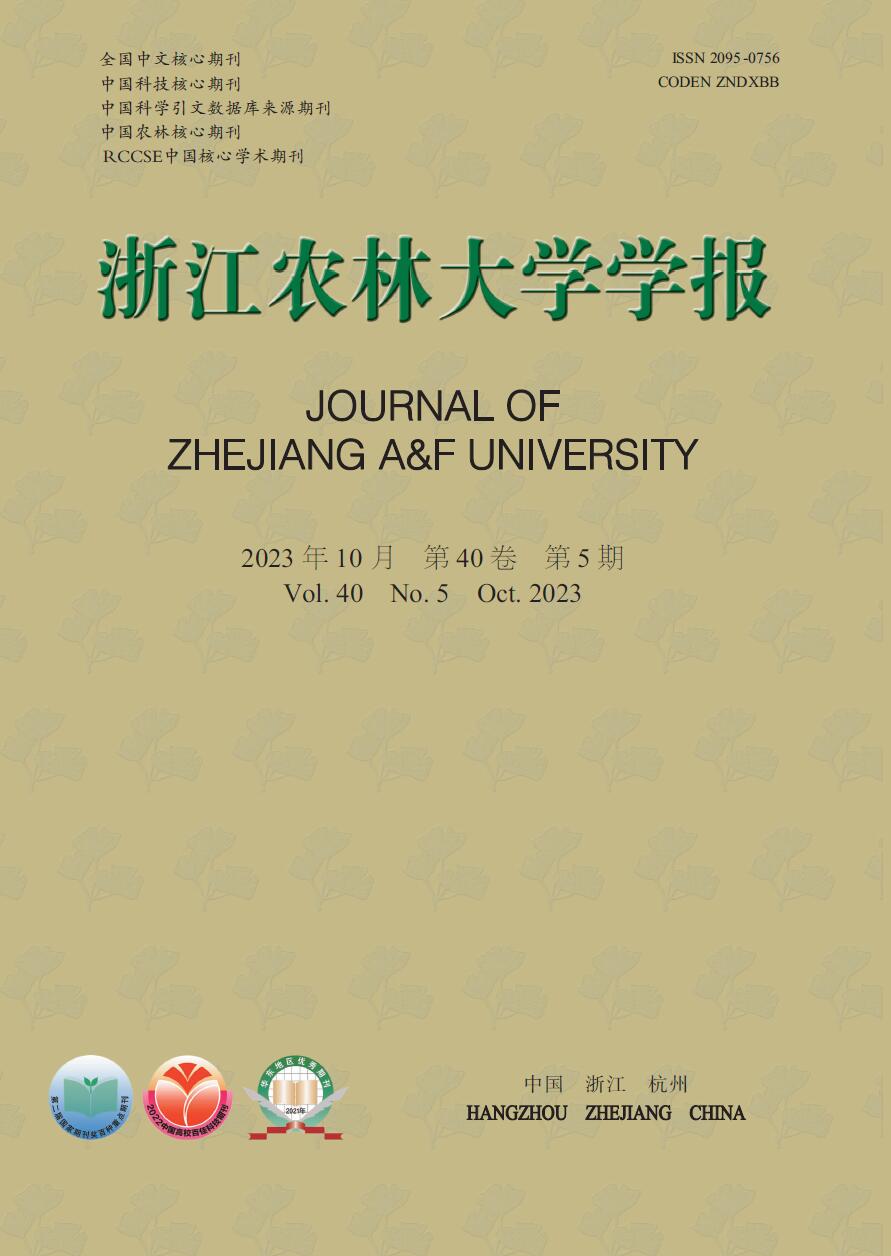


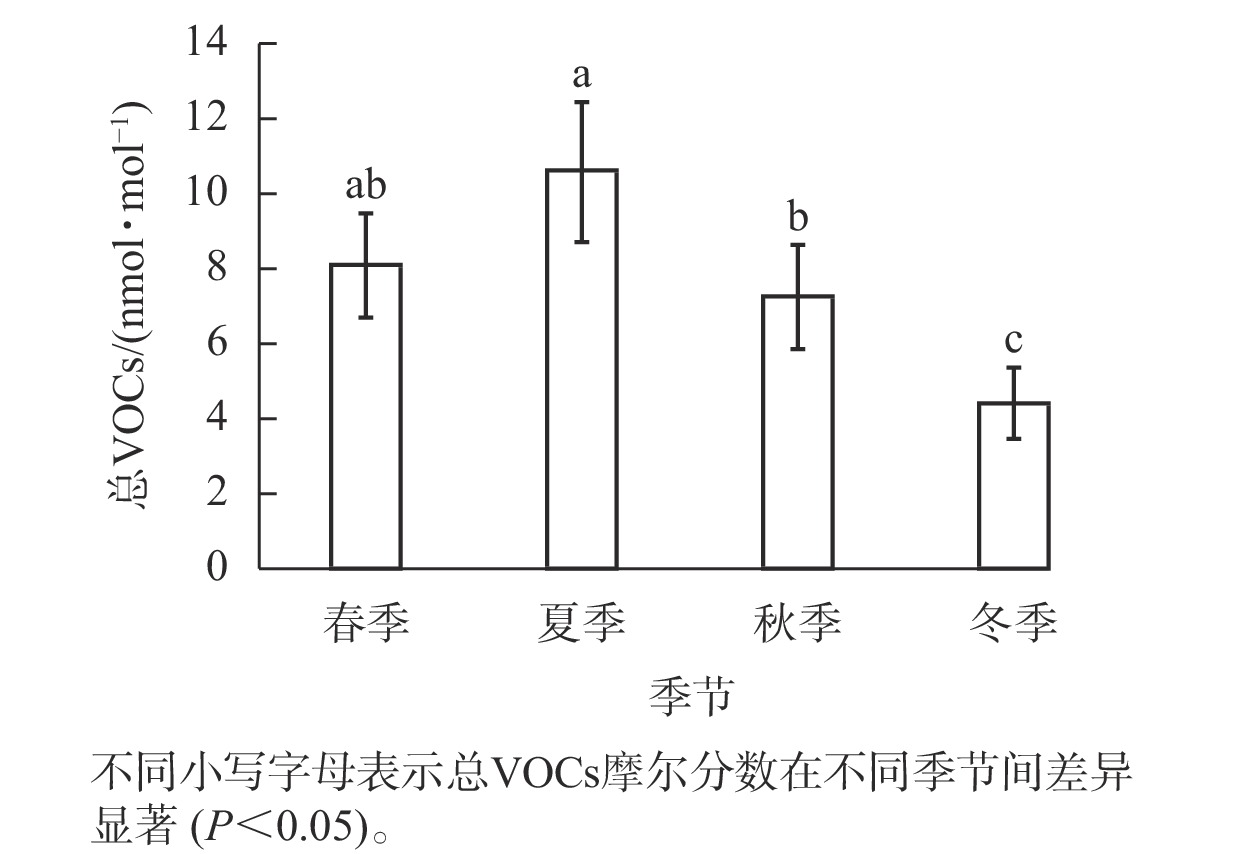


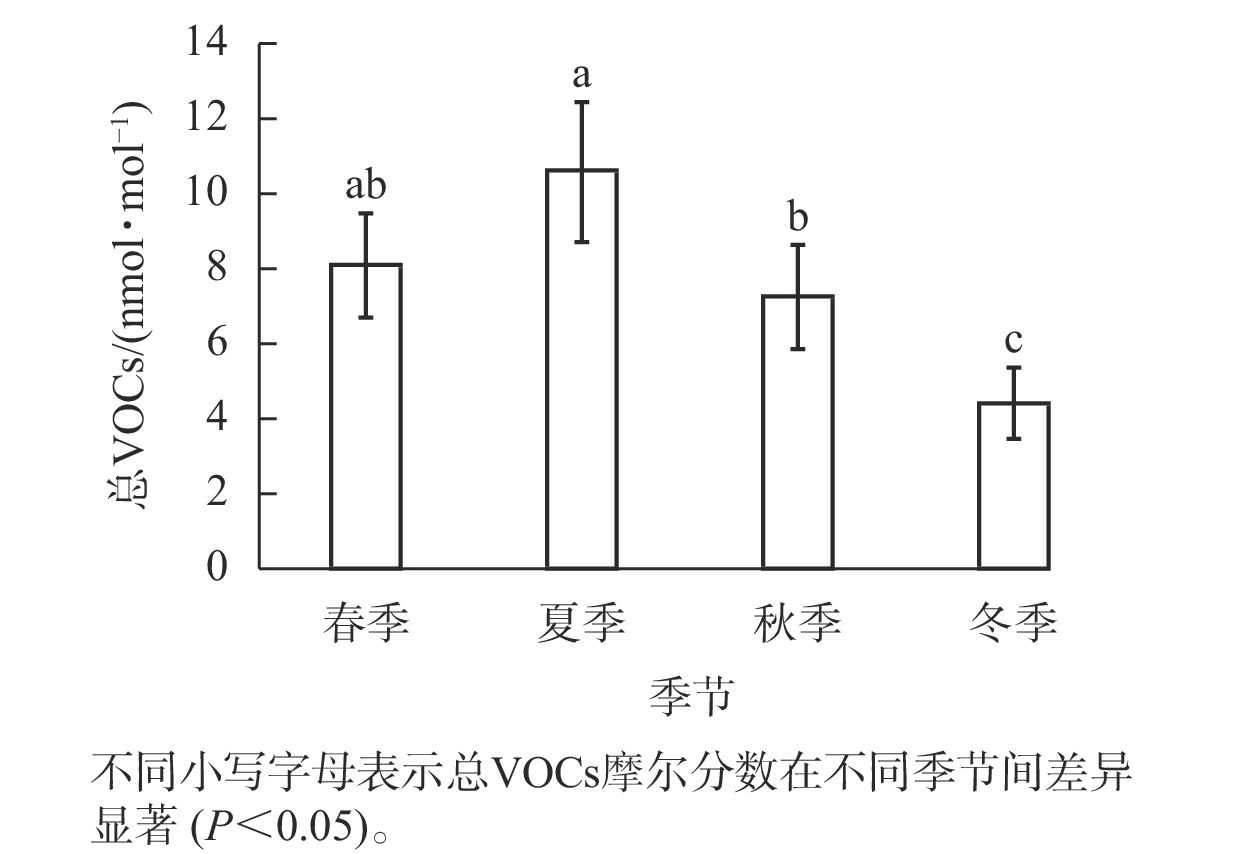
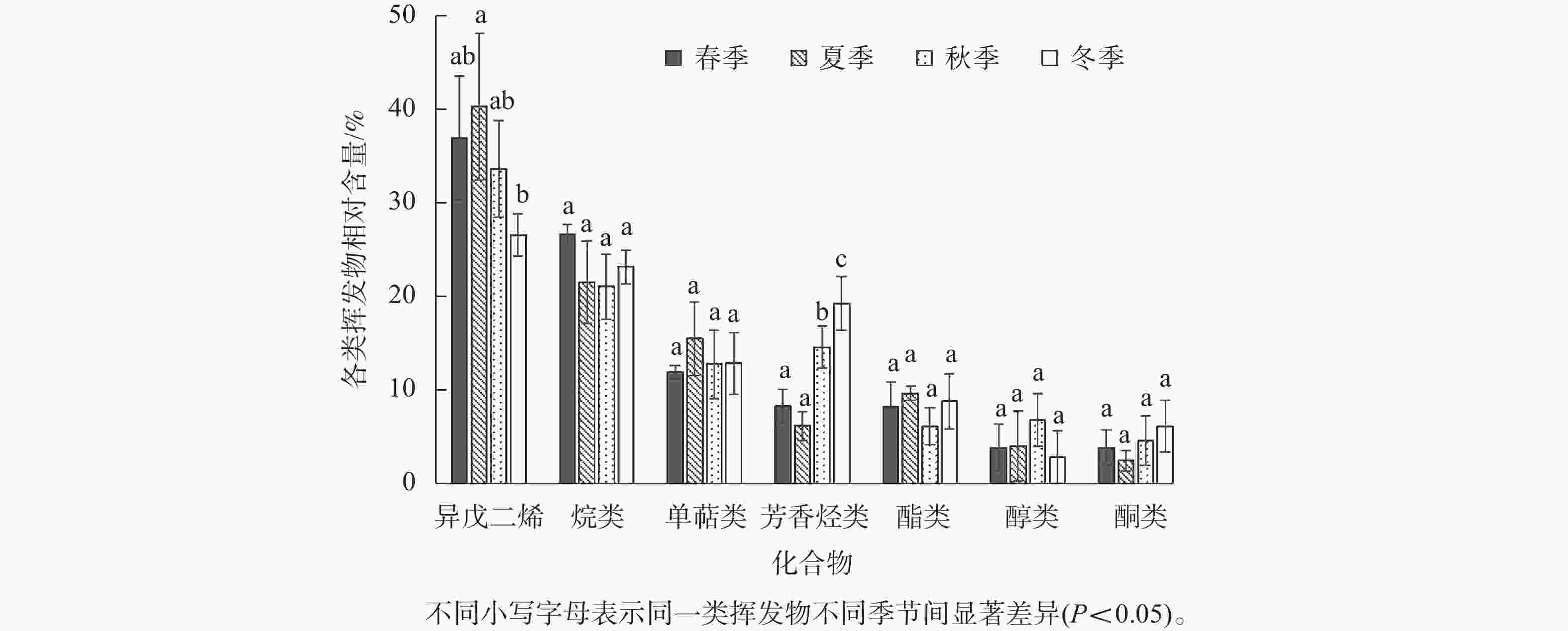

 DownLoad:
DownLoad:
